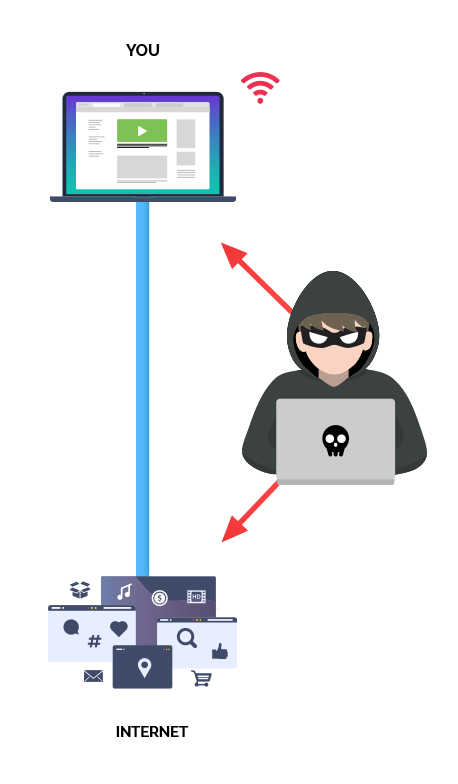In an age where digital interactions are ubiquitous, the need for secure communication has never been more paramount. Imagine a scenario where you are sitting in a bustling café, sipping your favorite beverage, and connecting to the free Wi-Fi offered. You might feel at ease, engrossed in your browsing, unaware of the unseen dangers lurking in the shadows. Have you ever pondered how hackers exploit such opportunities? Could it be possible that your private information is at risk without your knowledge? The answer lies within the realm of Man-in-the-Middle (MITM) attacks.
What exactly are MITM attacks, and how do they function? At its core, a MITM attack occurs when a malicious actor secretly intercepts and relays communications between two parties who believe they are directly communicating with each other. This form of intrusion allows the attacker to eavesdrop, manipulate, or steal sensitive information without the consent of the communicating parties.
Consider the traditional setup: you connect to a network and send a message to a friend. In an MITM scenario, the attacker sits in between you and your friend, capturing the information being exchanged while you remain oblivious to the invasion. The attacker can then alter the content of your messages, impersonate either party, or harvest sensitive data such as login credentials, personal details, or financial information.
The modus operandi of MITM attacks typically involves two primary types: passive and active. Passive MITM attacks involve the eavesdropping of communications, while active MITM attacks engage the attacker directly in the data transmission process. Active attacks may include techniques such as session hijacking, DNS spoofing, or HTTPS spoofing. Understanding these techniques not only enlightens one about the risks involved but also informs best practices for digital security.
One common method of executing a MITM attack is through ARP (Address Resolution Protocol) spoofing. In this scenario, an attacker sends false ARP messages onto a local network, associating their MAC address with the IP address of another device. This deception causes data packets intended for that IP address to be routed through the attacker’s device, allowing them to intercept all transmitted data. The stealthiness and simplicity of ARP spoofing make it a favored approach among cybercriminals.
Moreover, Wi-Fi networks, particularly public ones, serve as a prominent target for MITM attacks. Many users are unaware that unsecured networks do not encrypt the data sent over them, which creates an optimal environment for malicious activities. When users connect to these networks, attackers can use tools such as packet sniffers to capture unencrypted data flowing through the network. This is where caution becomes indispensable: a moment of negligence can lead to significant repercussions.
This brings us to the discussion of HTTPS and the various safeguards that can be implemented to mitigate the risks associated with MITM attacks. While HTTPS (Hypertext Transfer Protocol Secure) encrypts data between the user’s browser and the web server, it is essential to ensure that the website being visited is indeed secure. A misleading URL or a certificate warning can indicate an attempt at spoofing. Therefore, a keen eye for detail is crucial.
In addition to relying on HTTPS, employing Virtual Private Networks (VPNs) offers another layer of protection. A VPN encrypts all internet traffic, creating a secure tunnel between the user’s device and the VPN server, rendering it exceedingly challenging for attackers to intercept data. However, the selection of a reputable VPN service is paramount, as poorly managed VPN services can themselves be a source of vulnerability.
Further preventative measures include educating oneself about the signs of potential MITM attacks. For example, unexpected disconnections or slow internet speeds may suggest interference with data transmission. Additionally, implementing two-factor authentication (2FA) adds an extra barrier, even if a malicious actor manages to obtain login credentials.
The evolution of technology continues to spur innovative methods for securing communications, but the threat landscape also intensifies. As such, understanding the intricacies of MITM attacks empowers individuals to navigate the digital world more safely. It is imperative to remain vigilant and informed about potential cybersecurity threats and to adopt protective measures proactively.
Ultimately, the question remains: are you willing to gamble with your personal information? In an environment rife with malevolent actors, forgetting to take the necessary precautions can lead to dire consequences. By being aware of the tactics employed in MITM attacks and the tools available for protection, you can significantly minimize the risks involved in your digital communications.
In conclusion, as the prevalence of online communication continues to rise, so too does the sophistication of cyber threats. Awareness and proactive measures can significantly reduce your vulnerability in this digital landscape. Hackers thrive on complacency; it is the responsibility of every internet user to stay informed and safeguard their personal information against malicious intent.








Leave a Comment